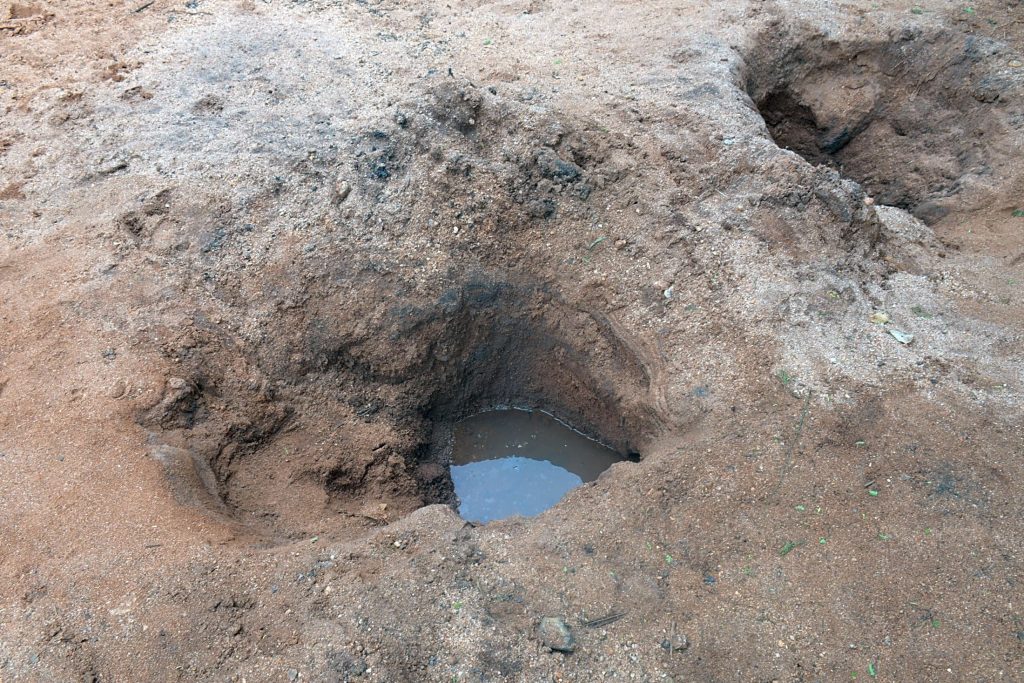What is a scoop hole?
Scoop holes are common where The Water Project works in sub-Saharan Africa, but other parts of the world will likely never have heard of one. Although you can infer a lot from the name itself, it doesn’t tell the whole story.
A scoop hole is a shallow hole dug down into the ground to access water just beneath the ground’s surface. People dig these holes in arid or semi-arid climates when there are no other water options, or when their usual water sources disappear along with the rains.

Scoop holes range in size depending on how long it takes to reach water. Scoop holes also expand as the dry season drags on due to a combination of erosion and further digging.
As you can imagine, the water people extract from these holes is highly contaminated, being exposed to the elements — and more.
“The water in our school is unclean and contaminated because it is acquired from scoop holes that are prone to animal and human contamination,” said 13-year-old Cynthia M. from Katse Primary School in Southeast Kenya, which is still raising funds to build its own rainwater harvesting tank.
“I have been sick several times during this term due to stomach upsets caused by drinking the contaminated water,” Cynthia continued. “I [am] usually forced to stay at home and seek treatment, forcing me to miss class lessons. I have to bear with the thirst during most days in school because there is little or no water in the school.”
There are many reasons why drinking water found in scoop holes could expose people to water-related diseases.
- Scoop holes leave their water vulnerable to debris, dust, and pollutants carried by wind or animals.
- Livestock and wildlife often share the same water sources as humans. Their presence near the scoop holes can introduce bacteria, parasites, and fecal matter into the water.
- People using scoop holes may contaminate the water with dirty containers or hands.
- Scoop holes lack any natural filtration, allowing sediment, pathogens, and pollutants from the soil and surrounding environment to enter the water.
- Water in scoop holes often sits for extended periods, becoming a breeding ground for bacteria and parasites.
- Groundwater accessed through scoop holes is often brackish or salty, making it unfit for drinking or household use.
- Scoop holes dug near latrines can become contaminated by sewage or other hazardous materials leaching into the ground.
“My primary water source is a scoop hole near my home, but the water is very dirty and unsafe,” said 26-year-old Christopher from Kisalizi Community in Uganda, which is still raising funds for a borehole well. “I assume that, this source being in a valley, rainwater carries feces [to] the water point. There are people who abandoned this scoop hole because there is someone who defecated in the water source.”
Believe it or not, the water from scoop holes is often in high demand — because it is people’s only option.
“The people (mostly women and children) wake up at dawn to search for water from the seasonal Ndalani river,” said Field Officer Alex Koech when describing Kilela Community, which is still raising funds for its own water project.
“They walk for about three hours to the scoop hole at Ndalani River,” Alex continued. “They have to wake up that early; otherwise, the water at the scoop hole runs out, and they have to wait ‘til it collects more water. The lack of water in the area has led to long queues at the water point, which at times leads to quarrels between the community members.”
You might wonder why the people living in these areas wouldn’t just go buy some water for themselves. But in sub-Saharan Africa, purchasing water is not always as simple as walking to a nearby store. Most people in our work areas farm for their food and their living, which is difficult without water available, so money is scarce. And in some cases, local water vendors have no other option but to source water from the same scoop holes.
But there’s hope for these communities.
The Water Project works tirelessly to bring water to communities in Kenya, Sierra Leone, and Uganda. By helping us build new water sources, you help people replace these unsafe scoop holes with sustainable water sources like wells, rainwater tanks, and sand dams. Your gift will reduce the hours women and children spend collecting water, giving them more time to focus on their education and their futures.
Donate today and give the gift of clean, safe water. Your contribution will make an immediate, life-saving difference for communities in need.
Home More Like ThisTweet